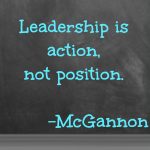 What defines effective leadership to drive positive sustainable change? I asked this question to all people I interviewed for my blog in the past three years. This post builds on their collective wisdom, quoting some of the best-read interviews, supplemented with my own views on the topic.
What defines effective leadership to drive positive sustainable change? I asked this question to all people I interviewed for my blog in the past three years. This post builds on their collective wisdom, quoting some of the best-read interviews, supplemented with my own views on the topic.
Personal commitment
 Leadership for sustainable changes starts with strong personal commitment to serve society at large, beyond the personal benefit. At the same time, the conviction has to be deeply personal, an authentic core to enable persistence and courage. In the face of uncertainty, yet with the certainty of setbacks on the journey, resilience is key to make change happen. As Nyenrode professor Andre Nyhof said in his interview, “You can’t wait for others to lead”.
Leadership for sustainable changes starts with strong personal commitment to serve society at large, beyond the personal benefit. At the same time, the conviction has to be deeply personal, an authentic core to enable persistence and courage. In the face of uncertainty, yet with the certainty of setbacks on the journey, resilience is key to make change happen. As Nyenrode professor Andre Nyhof said in his interview, “You can’t wait for others to lead”.
Inspiring vision
 Personal commitment is not enough. Leaders for sustainable change also need to have and share an inspiring vision. This sets the direction and ambition. Being clear about where we’re going – and where not – helps generate the focus needed for change. The vision needs to be integrated, combining prosperity
Personal commitment is not enough. Leaders for sustainable change also need to have and share an inspiring vision. This sets the direction and ambition. Being clear about where we’re going – and where not – helps generate the focus needed for change. The vision needs to be integrated, combining prosperity
for society with profitability for the organization. Ideally, the vision co-created with internal and external stakeholders to create stronger commitment. ING’s Sustainability Director Adrie Heinsbroek phrased it this way: “Change happens only when three conditions exist: people really want it, they believe it is possible and hard work. “
Clear plan
 The hard work takes people and a clear plan. As leadership coach and professor Christo Nel highlighted: “We need to move sustainability from principles and philosophy to practice and pragmatism.”
The hard work takes people and a clear plan. As leadership coach and professor Christo Nel highlighted: “We need to move sustainability from principles and philosophy to practice and pragmatism.”
 Big systemic change can be intimidating, so start small if you need to. A Beautiful Story Founder Cathelijne Lania said: “Small changes contribute to larger change.” Many small steps not only combine to a bigger one. Celebrating small successes along the way also helps to maintain commitment to a larger steps in the plan. As long as this is done, of course, without losing sight of the overarching larger direction and ambition.
Big systemic change can be intimidating, so start small if you need to. A Beautiful Story Founder Cathelijne Lania said: “Small changes contribute to larger change.” Many small steps not only combine to a bigger one. Celebrating small successes along the way also helps to maintain commitment to a larger steps in the plan. As long as this is done, of course, without losing sight of the overarching larger direction and ambition.
Empowered collaboration
 Another key element of effective leadership for change is the engagement and empowerment of many people to work together on designing and implementing solutions. This drives collaboration and contribution by the many people required to really make a difference. Innate Motion’s CEO Christophe Fauconnier said: “Societal issues cannot be solved in the boardroom; they need to be solved with and for the people closest to the problem.”
Another key element of effective leadership for change is the engagement and empowerment of many people to work together on designing and implementing solutions. This drives collaboration and contribution by the many people required to really make a difference. Innate Motion’s CEO Christophe Fauconnier said: “Societal issues cannot be solved in the boardroom; they need to be solved with and for the people closest to the problem.”
By engaging a variety of people and really empowering them, sustainability leaders foster creativity and innovation. Together, we can come up with better solutions. Leadership for change also requires a willingness to learn from others and to be vulnerable; a willingness to not always be the one who has all the answers. As Christo Nel phrased it: “Change happens at the edges, only by considering the full richness of diversity and going beyond preconceived ideas, we can grow and develop as humankind.”
Andre Nyhof added an important condition to inspire strong partnership: “Collaboration is much easier if based on instrumental intent rather than just the business case for sustainability.” This underlines the importance of personal commitment and vision.
Empathetic communications
 For change to really take effect and scale, leaders need to reach lots of people, beyond the team driving change. It’s all to easy to assume that simply sharing information is enough. But we’re not rational beings, so more information isn’t always the answer. Communication becomes more effective if it resonates with the receivers, not just the sender. So it’s up to change leaders to listen, respond, clarify. Jacqueline van Koert, Change and Corporate Responsibility Manager at Zwitserleven sums up how she does this: “Driving behavior change is easier when sustainability is translated into something really tangible and important.”
For change to really take effect and scale, leaders need to reach lots of people, beyond the team driving change. It’s all to easy to assume that simply sharing information is enough. But we’re not rational beings, so more information isn’t always the answer. Communication becomes more effective if it resonates with the receivers, not just the sender. So it’s up to change leaders to listen, respond, clarify. Jacqueline van Koert, Change and Corporate Responsibility Manager at Zwitserleven sums up how she does this: “Driving behavior change is easier when sustainability is translated into something really tangible and important.”
Effective communication is often about repetition, but not by resending the same information again and again. To drive change, you have to find new ways to share the same core content. Best practices and success stories are obvious content, but also consider sharing learnings from challenges and dilemmas along the way. And finally, let go of your ego to highlight the achievements and contributions of others.
So there they are, the key elements of effective leadership for positive sustainable change:
- Commitment
- Vision
- Planning
- Collaboration
- Communications
Which ones are your personal favorites? Which ones are easier to overlook? Please leave your thoughts in the comments box below.
Written by Marjolein Baghuis (@mbaghuis) for Change in Context. To read interviews with interesting people, book reviews and other posts about leadership, change, communications and sustainability, please subscribe.

After a bit of a summer break, the Change in Context blog is back! https://t.co/uGwEWgcH5a
What defines #leadership for positive #sustainable #change? A new blog building on past interviews https://t.co/dWtF7BHQ4s